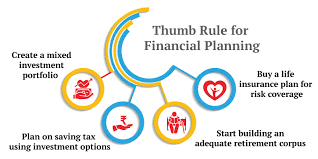In the fast-paced world of today, prudent money management is more crucial than ever.Whether you’re a young adult just starting your career, a growing family juggling multiple expenses, or someone planning for retirement, financial planning plays a critical role in ensuring stability and long-term prosperity.
Yet, many people overlook financial planning, either due to lack of awareness or the mistaken belief that it’s only for the wealthy. In reality, financial planning is essential for anyone who earns, spends, saves, or invests money. In this blog, we’ll dive deep into the concept of financial planning, explore its components, and offer actionable steps to create your own effective financial plan.
What Is Financial Planning?
The process of assessing your present financial status, establishing your long-term financial objectives, and developing a strategy to reach them is known as financial planning. It covers debt management, retirement planning, insurance, investing, saving, and budgeting. Ultimately, it provides structure, direction, and clarity when it comes to making financial decisions.
Think of financial planning as building a house. Your income is the foundation, your goals are the rooms, and your savings and investments are the walls that protect your financial future.
Why Financial Planning Matters
- Goal Achievement
Whether your goal is to buy a house, start a business, travel the world, or retire comfortably, financial planning helps you take deliberate steps toward making it happen. - Peace of Mind
Knowing that you have a plan in place to handle emergencies, manage debt, and save for the future reduces financial stress. - Better Decision-Making
A financial plan acts as a guide, helping you avoid impulsive decisions like overspending or investing in high-risk ventures without research. - Preparedness for Life Changes
Life is unpredictable—job changes, health issues, market downturns, or family emergencies. Financial planning ensures you are prepared for the unexpected. - Building Wealth
Through disciplined saving and investing, you not only protect your money—you grow it.
Key Components of a Financial Plan
- Budgeting
The foundation of any financial plan is a realistic, effective budget. Budgeting allows you to track income and expenses, prioritize needs over wants, and ensure you’re not spending more than you earn. - Saving
A good financial plan includes both short-term and long-term savings goals. This may include an emergency fund, a travel fund, or a savings account for a down payment on a home. - Debt Management
Managing and reducing debt is essential. Whether it’s student loans, credit cards, or mortgages, your plan should include strategies to minimize interest payments and become debt-free. - Investing
Investment planning involves putting your money to work so it can grow over time. A diversified portfolio aligned with your risk tolerance and financial goals is key. - Insurance and Risk Management
Life is full of uncertainties. Insurance protects you from major financial setbacks due to accidents, health issues, or loss of property. Life, health, auto, and home insurance are common essentials. - Retirement Planning
Early retirement planning allows your investments to grow and compound.Pension plans, retirement accounts, and personal investments all play a role. - Tax Planning
Effective tax planning can save you a substantial amount of money. By understanding deductions, credits, and tax-deferred accounts, you can minimize liabilities and retain more of your income.
Steps to Create a Personalized Financial Plan
- Assess Your Current Financial Situation
Begin by calculating your income, expenses, savings, debts, and net worth. Understanding where you stand is crucial before setting goals. - Define Your Financial Goals
Set SMART goals—Specific, Measurable, Achievable, Relevant, and Time-bound. For example, “Save PKR 500,000 in 2 years for a car” is a concrete, measurable goal. - Create a Budget and Track Spending
Use budgeting tools or apps to monitor where your money goes each month. Categories should include essentials (rent, groceries), savings, debt payments, and discretionary spending. - Create an Emergency Fund
- In an easily accessible, interest-bearing account, try to save three to six months’ worth of living expenses.This provides a cushion financial planning during unexpected events like job loss or medical emergencies.
- Develop a Debt Repayment Strategy
Choose a method that works for you—the snowball method (paying off smallest debts first) or avalanche method (tackling high-interest debt first). Be consistent and avoid accumulating new debt. - Start Investing Wisely
Don’t wait for a large sum of money to begin investing. Over time, even modest monthly contributions to a mutual fund or retirement account can increase substantially. Think about your time horizon, risk tolerance, and age. - Get Insured
To make sure you and your family are sufficiently covered, review your insurance policy. Life, health, and property insurance should be reviewed and updated regularly. - Plan for Taxes
Understand how your income is taxed, explore available deductions, and consider investing in tax-advantaged accounts to reduce your annual tax burden. - Monitor and Adjust Your Plan
Your financial plan is not static. Life changes—marriage, career shifts, children, inflation—require you to revisit and adjust your plan regularly.
Common Financial Planning Mistakes to Avoid
- Ignoring Inflation: Your money may lose value if you don’t take into account how inflation affects purchasing power over time.
- Lack of Emergency Savings: Without a financial cushion, even small setbacks can lead to major debt.
- Overspending: Not living within your means makes achieving financial goals nearly impossible.
- Delayed Investing: Your money can grow more if you start early. Don’t wait for “perfect timing.”
- Failure to Plan for Retirement: Relying solely on pensions or government benefits may not be enough.
Tools and Resources for Financial Planning
There are many digital tools and apps that simplify financial planning:
- Mint – Budgeting and expense tracking
- YNAB (You Need a Budget) – Budgeting based on zero-based principles
- Personal Capital: Monitoring net worth and managing investments
- Excel/Google Sheets – For DIY budgeting and goal setting
You may also consider consulting a Certified Financial Planner (CFP) for more personalized, professional guidance, especially for complex financial situations.
Final Thoughts
Financial planning is not about being restrictive—it’s about being intentional. No matter your income level or life stage, a well-thought-out financial plan is a powerful tool that helps you build security and success over time.
Remember: The best time to start financial planning was yesterday. The next best time is today.
See more our website visit here



